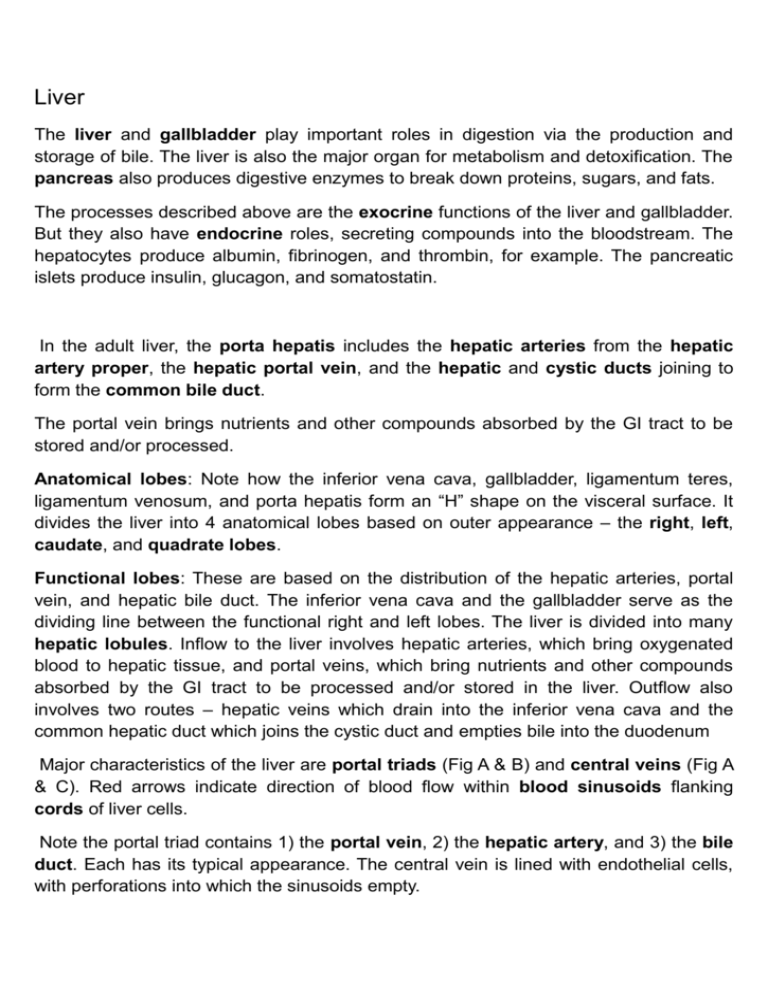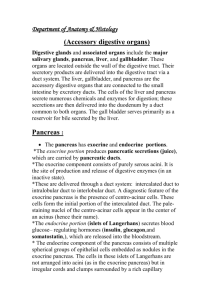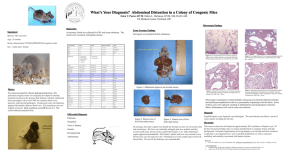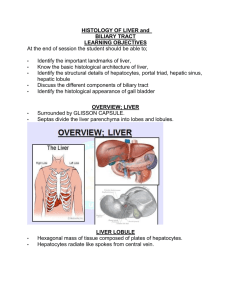liver
advertisement

Liver The liver and gallbladder play important roles in digestion via the production and storage of bile. The liver is also the major organ for metabolism and detoxification. The pancreas also produces digestive enzymes to break down proteins, sugars, and fats. The processes described above are the exocrine functions of the liver and gallbladder. But they also have endocrine roles, secreting compounds into the bloodstream. The hepatocytes produce albumin, fibrinogen, and thrombin, for example. The pancreatic islets produce insulin, glucagon, and somatostatin. In the adult liver, the porta hepatis includes the hepatic arteries from the hepatic artery proper, the hepatic portal vein, and the hepatic and cystic ducts joining to form the common bile duct. The portal vein brings nutrients and other compounds absorbed by the GI tract to be stored and/or processed. Anatomical lobes: Note how the inferior vena cava, gallbladder, ligamentum teres, ligamentum venosum, and porta hepatis form an “H” shape on the visceral surface. It divides the liver into 4 anatomical lobes based on outer appearance – the right, left, caudate, and quadrate lobes. Functional lobes: These are based on the distribution of the hepatic arteries, portal vein, and hepatic bile duct. The inferior vena cava and the gallbladder serve as the dividing line between the functional right and left lobes. The liver is divided into many hepatic lobules. Inflow to the liver involves hepatic arteries, which bring oxygenated blood to hepatic tissue, and portal veins, which bring nutrients and other compounds absorbed by the GI tract to be processed and/or stored in the liver. Outflow also involves two routes – hepatic veins which drain into the inferior vena cava and the common hepatic duct which joins the cystic duct and empties bile into the duodenum Major characteristics of the liver are portal triads (Fig A & B) and central veins (Fig A & C). Red arrows indicate direction of blood flow within blood sinusoids flanking cords of liver cells. Note the portal triad contains 1) the portal vein, 2) the hepatic artery, and 3) the bile duct. Each has its typical appearance. The central vein is lined with endothelial cells, with perforations into which the sinusoids empty. Fig A Fig B Fig C The central veins lead to sublobular veins, which reach collecting veins, hepatic veins, and finally the inferior vena cava. The venous outflow of the liver has no regard to the organization of the lobules. The liver sinusoids are shown in higher magnification in Fig D. They are dilated, capillary-like vessels lined by fenestrated, discontinuous epithelium (labeled “e”). Interspersed among the endothelial cells are Kupffer cells (labeled “k”), which are fixed macrophages within the hepatic tissue. They have distinct cytoplasm that may enter the sinusoidal lumen and function like other macrophages within the body. They also break down damaged red blood cell hemoglobin. In the Fig E, there are many spaces between the hepatocytes and sinusoidal epithelial cells marked by arrowheads. They are referred to the space of Disse where exchange between hepatocytes and blood flow takes place. Once again, Fig F, we review the Kupffer cell, endothelial cell of the liver sinusoid, and the space of Disse. Fig D Fig E Fig F The liver lobules can be defined in 3 ways: 1) Classic lobule – centered around the central vein with the portal triads at each corner. Shown in Fig G, the classic lobule may not always be hexagonal in shape. 2) Portal lobule (not shown) – centered on the portal triad, based on bile secretion, and approximately triangular in shape. 3) Liver acinus of Rappaport – this is the most functionally important classification. Shown in Fig H, the acinus is roughly oval in shape with 2 central veins and 2 portal triads on opposite ends. Based on the blood flow within hepatic tissue, the acinus is divided into 3 zones. Cells in different zones are specialized for different activity. Zone 1 cells, being closest to the portal triads and hence most oxygenated blood, have the most drug-metabolizing enzymatic activity. Following that same reasoning, zone 3 hepatocytes near the central veins are most susceptible to ischemia. Fig G Fig H As mentioned earlier, the liver has both endocrine and exocrine functions. The various proteins that hepatocytes secrete enter the bloodstream via the liver sinusoids. The liver also secretes bile in the conventional exocrine fashion. The hepatocytes secrete bile into sealed extracellular spaces called bile canaliculi. The typical “chicken-wire” appearance is more easily visualized with silver stain. Once again, inflow to the liver involves oxygenated blood via hepatic arteries and absorbed nutrients and compounds from the GI tract via the hepatic portal veins. All venous drainage from the GI tract and abdominal visceral organs enters the portal system back to the liver. The overall order is as following: arteries → capillaries → veins → portal vein → hepatic sinusoids → veins → vena cava → heart. In contrast, the caval system is as following: arteries → capillaries → veins → vena cava → heart. Obviously, this is the circulatory system within the rest of the body. The gallbladder is found under the right lobe of the liver. Its function is to store bile produced by the liver, which leaves via the cystic duct. It also enters the gallbladder in the cystic duct, traveling retrograde when the bile is not needed for digestion. Note the fundus, body, neck, and infundibulum of the gallbladder. Note in Fig K, the right and left hepatic ducts coming together as the common hepatic duct, joining the cystic duct to form the common bile duct. This descends to the 2nd part of the duodenum, is joined by the pancreatic duct, and empties its contents into the duodenal lumen via the major duodenal papilla. The gallbladder is supplied by the cystic artery, which is extremely important to find during a cholecystectomy. In most people it branches off the right hepatic artery, but could also come off the left hepatic, proper hepatic, or gastroduodenal arteries. Note In Figs L & M, the extensive folds of mucosa extending into the lumen, consisting of tall, simple columnar epithelium. The underlying connective tissue is comprised of lamina propria, with no distinctly defined submucosa. There are scattered bundles of smooth muscle in the muscularis. The adventitia has rather dense connective tissue connecting the gallbladder to the liver. Fig K Fig L Fig M Pancreas The pancreas contains multiple ducts, but the main pancreatic duct runs from the tail to the head of the pancreas. There may be a smaller accessory pancreatic duct. They join the common bile duct to empty into the duodenum. The pancreas is retroperitoneal. Histologically, we can see the septa (S) between pancreatic lobules with interlobular ducts (D). As mentioned above, the pancreas also has both exocrine and endocrine functions. Most in Fig O is filled with exocrine pancreatic tissue. Secretory portions are called acini. The scattered endocrine islets of Langerhans (I) are paler staining. An islet is magnified in the Fig P. It is a compact mass of epithelial cells that receive rich vascular supply (arrows). It is typically very difficult to identify the different cell types in the islets. Briefly, the alpha cells secrete glucagon, the beta cells secrete insulin, and the delta cells secrete somatostatin. Fig O Fig N Fig P Once again, most of the pancreas contains exocrine acini. Pancreatic enzymes are very diverse, including extremely efficient proteases, lipases, and amylases. Separate acini are shown in the Fig Q. The pancreatic acinar or secretory cells are polarized, meaning the basal portions are filled with basophilic rough ER. The apical regions are filled with zymogen granules that contain many stored pro-enzymes. Centroacinar cells, with paler staining, can be seen in the middle of some acini and mark the beginning of the duct system (marked “A” in the Fig Q). They converge at “B” to form intercalated ducts, marked as “C”. The intercalated duct cells may be hard to identify, but they actively pump water and bicarbonate into the duct lumen. Intercalated ducts empty into interlobular ducts, marked as “small duct” in the Fig R, which lead to the main pancreatic duct. Fig Q Fig R







